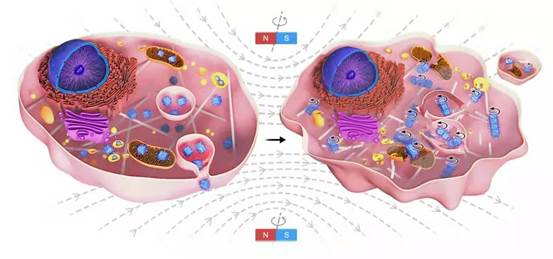Force
exists in all scales of life and plays a vital role in regulating cell
proliferation, differentiation and death. Micromagnetic therapy is a new
anti-tumor strategy by coupling magnetic materials and magnetic fields to
generate mechanical force, which has the advantages of high precision, deep
penetration and controllable space and time. However, large particles are difficult
to absorb and degraded, and for small particles, due to their weak magnetic
induction, it’s hard to produce strong mechanical force to kill tumor cells. How
to use magnetic force safely and effectively is a great challenge.

In
order to solve the key problem, CHENG Yu, Tongji University School of Medicine,
LIU Zhongmin, Affiliated East Hospital and Maciej. S.
Lesniak, Northwestern University School of Medicine, worked together, adopting the
self-assembly model of “group-scale operations” and "accurate attack"
targeting mitochondrial and achieving tumor damage through ultra-small-size
magnetic nanomaterials (MNPs). The team designed mitochondrial-targeted 20 nm
zinc-doped ferrite nano cubes, which were assembled into a micron-sized
magnetic knife under a rotating magnetic field to generate ~ 12 pN shear force
inhibiting tumor growth effectively, and proved that magnetic forces for 30
minutes could induce tumor cells apoptosis, and further demonstrate the
effectiveness and safety of magnetic treatment on brain tumor model. This work
was published online in Small on December 23, 2019, titled "Remote Control
of Mechanical Forces via targetable Magnetic Nanospinners for Efficient Cancer
Treatment" (DOI: 10.1002/ sml.201905424).The paper elucidated three key points:
selective target mitochondria to enhance destructive effect of magnetic force;
under rotating magnetic field, the magnetic knife structure is assembled and generates
sufficient shear force to destroy mitochondrial, eventually kills tumor cells,
which could effectively inhibit the growth of brain tumors in animal models;
safe ultra-low 15 Hz frequency magnetic field, achieving precise control of
magnetic force in space and time, without heat signal or other side effects. The
job will promote the development of platforms and devices related to magnetic
therapy and accelerate clinical transformation for brain tumors.
The co-first
authors of the thesis are CHEN Mengwei, a postgraduate, and WU Jiaojiao, a
doctoral student of CHENG Yu's team. The co-corresponding authors are Prof. CHENG
Yu, Prof. LIU Zhongmin, and Prof. Maciej. S. Lesniak. This project is strongly
supported by Special Development Fund of Zhangjiang National Independent
Innovation Demonstration Zone, the National Natural Science Fund, Major
Innovation Projects of Scientific Research Innovation Plan of Shanghai
Education Commission, Shanghai Science and Technology Commission and the Central
University Fund.
